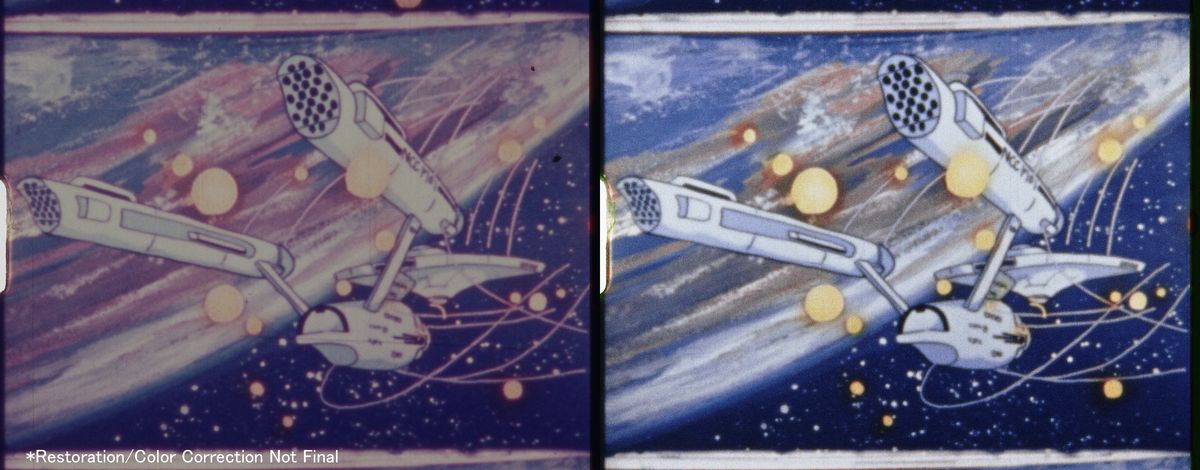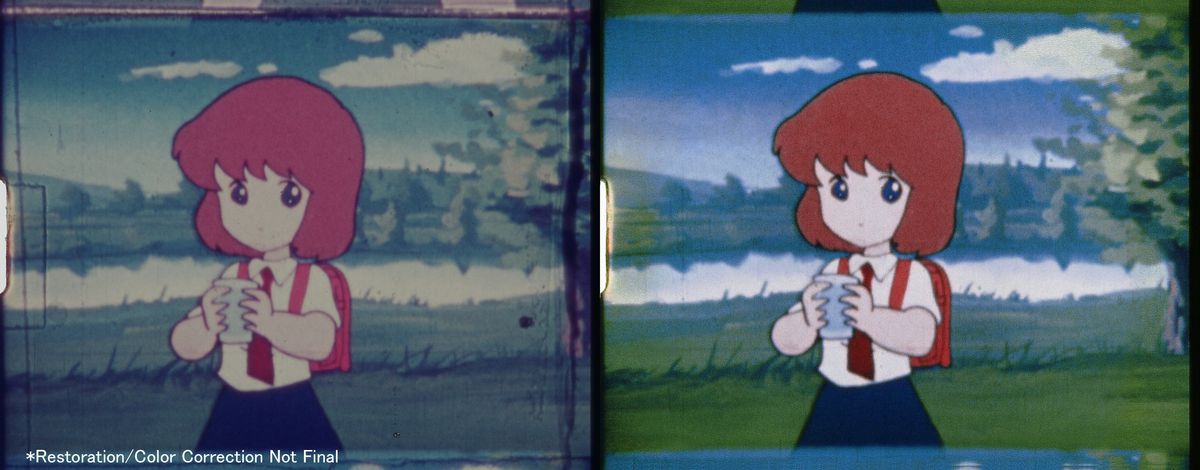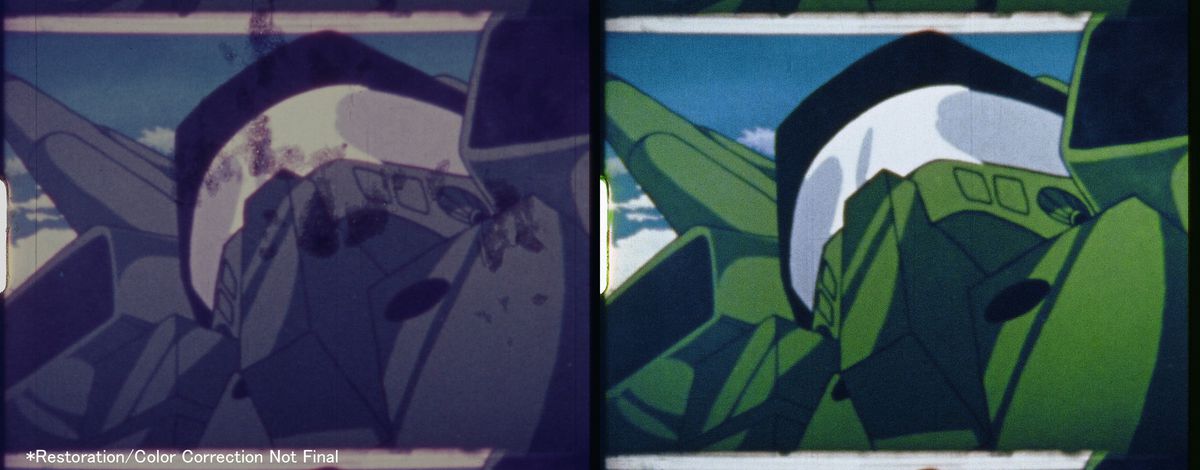Neon Genesis Evangelion animator Hideaki Anno built his career on pushing boundaries, whether they be his physical limits or the rules of his industry. In 1981, he and a few of his friends were tasked with creating an animated short film to open the Nihon SF Taikai convention in Osaka, Japan. The completed project came to be known as DAICON III Opening Animation.
To make the film, Anno’s team worked day and night, using money-saving non-standard vinyl sheets as animation cels and a consumer 8mm camera to cut costs wherever they could. They also borrowed liberally from other properties, piecing together sci-fi iconography to tell a story in which a young schoolgirl dodges everything from a Star Wars-esque Star Destroyer to Gomora from Ultraman to deliver a cup of water to a shriveled daikon radish (that turns into a spaceship when in contact with water). The animators exhausted themselves to get it all done, and as the story goes, only delivered the finished film on the morning of the Nihon SF Taikai convention. But the film was a hit, and the team later made their money back by selling unauthorized 8mm prints to the public following the event. Their collective, DAICON Film — consisting of now-legendary anime talent like Anno, Takami Akai, Hiroyuki Yamaga and producers Toshio Okada and Yasuhiro Takeda, among others — would later evolve into their own professional anime studio, the iconic Studio Gainax, which would go on to produce classics like Evangelion.
For years, the only way to see DAICON III was through unofficial, low-quality uploads of the project online. Given that it features IP from other companies used without permission, the official barriers seem unlikely to change. That’s why a group of fans took it upon themselves to remaster the proto-Gainax film in an effort of preservation. Using an unofficial print, the team at Femboy Films is bringing every frame into HD to secure its place in anime history. But alongside the technical challenges, there’s another hurdle standing in the way of the project: a copyright notice from Gainax. The snag has brought the question of the legal status of doujin media, a Japanese term for independent, unofficial work based on other properties, to the fore.

DAICON III is one of the most prominent early examples of modern-day derivative doujin media. These fan works are built on questionable legal grounds: ones that have locked this short film, alongside its successor, into a state of purgatory. While doujin works can be original properties created by individuals or small groups, a large proportion of these projects are derivative and make use of the properties of others without permission.
Japanese IP holders generally avoid legal action against doujin work: Many license holders see the industry as free promotion for their properties. These unofficial works are also seen by many creators in the anime and manga industries as a testing ground, allowing creators to hone their craft before making the jump into professional work. Anno had the opportunity to be involved in popular anime works Nausicaä and the Valley of the Wind and Macross as a result of his work here, while the funds raised helped them form Gainax.
DAICON III was also released at a time when high-profile events were shifting public perceptions of anime from an underground subculture and a junk medium for children into a legitimate part of Japanese popular culture. In the same year as the short’s release, Yoshiyuki Tomino hosted a launch event for the first Mobile Suit Gundam recap movie. The Shinjuku event, known as the New Century Declaration, was initially expecting hundreds of people in front of Shinjuku Station but ballooned into a 20,000 person gathering too big for news outlets and the general public to ignore. As anime took center stage, DAICON III portrayed otaku culture and represented these fans during this crucial turning point.
Yet despite all of this, aside from a few references in Gainax-produced works like Otaku no Video and FLCL, these short films have been left to rot in obscurity. This likely isn’t by choice, as there have been various unofficial releases of DAICON III, including a 1988 Laserdisc and VHS release show. But as works that flagrantly used IP from Gundam to Star Wars to Godzilla without permission, even our late-capitalist age of cross-IP contamination hasn’t cultivated a climate that would allow notoriously conservative Japanese licensors to work together on an official release. But then, if Gainax can’t release it, who else can ensure an important work is preserved for the future?

Image: Gainax/Femboy Films
This would be where fans step in to plug the gap where commercial releases either aren’t or won’t be possible. But while groups of passionate animation fans have stepped in to restore and preserve Western animation, very few groups exist that are dedicated to anime history. One exception is the restoration group Femboy Films, which specializes in preserving classic Japanese media like mostly-forgotten Dr. Slump PSA anime specials, old theatrical trailers for Detective Conan and Disney, lost 1980s Shonen Jump TV commercials, and more. At the end of last year, it took on the task of preserving and restoring DAICON III.
“I realized how perfect of an opportunity it would be for our group to preserve and restore this important piece of art,” explained David, a founder and the head of Femboy Films, in a text correspondence regarding the project. “That being said, what we are using is by no means a pristine, or original, copy of the film. It is a very amateurish copy of an already amateur-level film, so there were naturally going to be many hurdles to get it looking pristine again.”
Since initially scanning a reproduction 8mm print of the film late last year, Femboy Films has been correcting damage incurred over time, such as fading color and tearing, to create a transformative restoration that promised to be the highest-quality public release of the film to date. Femboy Films volunteer Quazza went frame-by-frame to correct imperfections such as scratches on the original print, while Enigmo restored the colors using reference material and original cel artwork. Meanwhile, Camhcom worked on a new stereo sound mix using as many original elements of the film as the group could gather. Femboy Films shared its progress on Twitter, showcasing comparison shots that were widely shared on social media and even earned the attention of the original staff. But now, that work might never see the light of day.
On July 10, Femboy Films announced that it planned on releasing its version of DAICON III in late August. Just two weeks later, the team received a copyright notice from Gainax, which Polygon has viewed, requesting that they cancel the imminent release of the remaster. On July 23, the group announced the suspension of its work in a statement on social media, stating that “GAINAX reached out to us asking us to refrain from posting our finished product. Up to now, we have been unable to come to a conclusion where they will allow us to upload the film, so we have no choice but to officially cancel our scheduled upload until further notice.”
In Twitter replies, the team noted hat it may have been a mistake to build public excitement for the project, but no one had thought it would become an issue given the uncertain legal status of DAICON III. “Because of the extremely complicated copyright situation, we assumed that Gainax would be unable to claim ownership of the film strong enough to warrant us to cease development,” David said in a follow-up interview following the legal notice. “In fact, one of the producers of the film, Akai Takami, followed us and liked the majority of our tweets regarding the restoration, making us think he approved of the work. We thought that maybe Gaianx, due to the, well, precarious situation they’re in right now, might have been nice enough to support us or at least turn a blind eye, but this was not the case.”
Today, Gaianx is a shade of its former self, with the staff that founded the company fragmented elsewhere. Anno left to found Studio khara in 2006, with control over the Evangelion franchise, while other staff split to form Studio Trigger in 2011. Nevertheless, the rights to certain properties, including DAICON III and the follow-up short DAICON IV, remain at the beleaguered company. Even though the company has no claim over the various intellectual property used within DAICON III, Gainax has ownership of the copyright for the film as a whole, including the original work within it.
As a result, even though Gainax can’t release the film given that it borrows from other properties, the company seems to be motivated to avoid risking the infringement of other IP through their work. David said, “I was initially skeptical whether or not I should take them seriously. But as I read on, I learned that the man who was contacting me had worked on these films himself, he was one of the producers, one of the members of DAICON FILM. It got to me, and I ultimately decided to comply.”
As of now, the project is unlikely to see the anticipated public release due to the legal threats posed to the team by Gainax. While the team at Femboy Films put many months of work into restoring the print at the time of the notice being received, any remastering work will now remain solely in the hands of those who worked on it.
“I’m in a bit of a state of shock and devastation following this, to tell you the truth,” David said. “We’d been working on this for so long, put so much effort and time into planning it all out and were thrilled to see how many people wanted to see it and who were supporting us. They [GAINAX] didn’t want to tell me if they have plans for the film themselves, so I am left guessing.
“I’m not sure where to go from here, to be honest. Just gotta keep moving. Work on more stuff. Silently.”

Image: Gainax/Femboy Films
Typically, major preservation efforts are done by companies based on commercial motivations rather than historical importance or even popularity. This can result in important anime falling into obscurity, as well as deliberately condemn certain media into obsolescence. For instance, the initial 1973 anime adaptation of popular anime Doraemon hasn’t aired on TV since 1979, and very little public footage of this first attempt of bringing the iconic character to life exists, with attempts to broadcast, screen or preserve the surviving older episodes being halted by the rights holders due to the risk of damaging the reputation of the franchise. When companies won’t or can’t remaster or preserve works, it becomes a necessity for fans to jump in, no matter the challenge.
What is remastering DAICON III if not a celebration of a shared love of otaku culture, just like the original film? When DAICON Film created the original DAICON III, the group created it through passion, not rules. Many of its key creators took this to heart, with Anno showing in all his subsequent work a willingness to push the boundaries and rules of the mediums he worked with. Like DAICON Film before them, Femboy Films hoped to celebrate a medium it loves. A fan-produced remaster recaptures the same spirit that brought this film into existence in the first place.
Business realities can often clash with fan works. These conflicts only become more complex when fans are driven by the same passion to honor a work as the original’s creators. There may not be a perfect answer to what can or should be done to ensure unofficial works like DAICON III are memorialized without copyright getting in the way. But art suffers when important works like these are forgotten to time.
Polygon – All
Source link
Related Post:
- Evangelion 3.333 Remastered 4K Blu-Ray Releasing in August
- Shinkalion Z Anime to Air Evangelion Crossover Episode
- Switch eShop deals – 80’s Overdrive, Assassin’s Creed III: Remastered, Spice and Wolf VR, Thomas Was Alone, more
- The Witcher: Nightmare of the Wolf anime creators hope to get their sequel
- Star Wars anime Visions trailer, studios, release date announced at Anime Expo
- Mobile Suit Gundam movies are a perfect Netflix watch for anime fans, old or new
- Nexus Mods is getting collections, but creators won’t be able to delete their mods
- Half-Life 2 Remastered Collection is fan-made but reportedly has Valve’s “consent” • Eurogamer.net
- Bo Burnham’s Inside tackles depression like real world Evangelion
- Evangelion 1.0+3.0: Thrice Upon a Time review: Finally, the endless story ends
